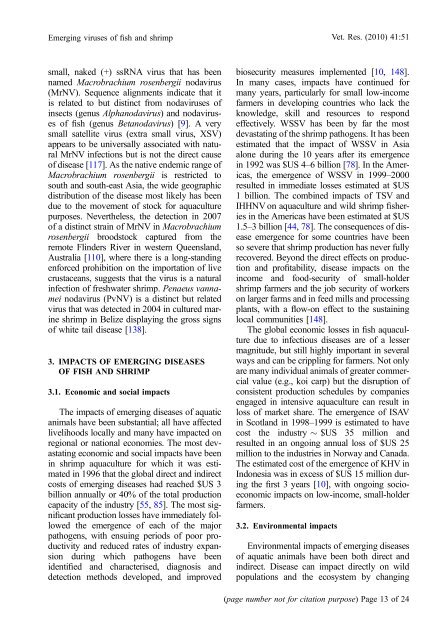Emerging viral diseases of fish and shrimp - Watershed Watch ...
Emerging viral diseases of fish and shrimp - Watershed Watch ...
Emerging viral diseases of fish and shrimp - Watershed Watch ...
You also want an ePaper? Increase the reach of your titles
YUMPU automatically turns print PDFs into web optimized ePapers that Google loves.
<strong>Emerging</strong> viruses <strong>of</strong> <strong>fish</strong> <strong>and</strong> <strong>shrimp</strong> Vet. Res. (2010) 41:51<br />
small, naked (+) ssRNA virus that has been<br />
named Macrobrachium rosenbergii nodavirus<br />
(MrNV). Sequence alignments indicate that it<br />
is related to but distinct from nodaviruses <strong>of</strong><br />
insects (genus Alphanodavirus) <strong>and</strong>nodaviruses<br />
<strong>of</strong> <strong>fish</strong> (genus Betanodavirus) [9]. A very<br />
small satellite virus (extra small virus, XSV)<br />
appears to be universally associated with natural<br />
MrNV infections but is not the direct cause<br />
<strong>of</strong> disease [117]. As the native endemic range <strong>of</strong><br />
Macrobrachium rosenbergii is restricted to<br />
south <strong>and</strong> south-east Asia, the wide geographic<br />
distribution <strong>of</strong> the disease most likely has been<br />
due to the movement <strong>of</strong> stock for aquaculture<br />
purposes. Nevertheless, the detection in 2007<br />
<strong>of</strong> a distinct strain <strong>of</strong> MrNV in Macrobrachium<br />
rosenbergii broodstock captured from the<br />
remote Flinders River in western Queensl<strong>and</strong>,<br />
Australia [110], where there is a long-st<strong>and</strong>ing<br />
enforced prohibition on the importation <strong>of</strong> live<br />
crustaceans, suggests that the virus is a natural<br />
infection <strong>of</strong> freshwater <strong>shrimp</strong>. Penaeus vannamei<br />
nodavirus (PvNV) is a distinct but related<br />
virus that was detected in 2004 in cultured marine<br />
<strong>shrimp</strong> in Belize displaying the gross signs<br />
<strong>of</strong> white tail disease [138].<br />
3. IMPACTS OF EMERGING DISEASES<br />
OF FISH AND SHRIMP<br />
3.1. Economic <strong>and</strong> social impacts<br />
The impacts <strong>of</strong> emerging <strong>diseases</strong> <strong>of</strong> aquatic<br />
animals have been substantial; all have affected<br />
livelihoods locally <strong>and</strong> many have impacted on<br />
regional or national economies. The most devastating<br />
economic <strong>and</strong> social impacts have been<br />
in <strong>shrimp</strong> aquaculture for which it was estimated<br />
in 1996 that the global direct <strong>and</strong> indirect<br />
costs <strong>of</strong> emerging <strong>diseases</strong> had reached $US 3<br />
billion annually or 40% <strong>of</strong> the total production<br />
capacity <strong>of</strong> the industry [55, 85]. The most significant<br />
production losses have immediately followed<br />
the emergence <strong>of</strong> each <strong>of</strong> the major<br />
pathogens, with ensuing periods <strong>of</strong> poor productivity<br />
<strong>and</strong> reduced rates <strong>of</strong> industry expansion<br />
during which pathogens have been<br />
identified <strong>and</strong> characterised, diagnosis <strong>and</strong><br />
detection methods developed, <strong>and</strong> improved<br />
biosecurity measures implemented [10, 148].<br />
In many cases, impacts have continued for<br />
many years, particularly for small low-income<br />
farmers in developing countries who lack the<br />
knowledge, skill <strong>and</strong> resources to respond<br />
effectively. WSSV has been by far the most<br />
devastating <strong>of</strong> the <strong>shrimp</strong> pathogens. It has been<br />
estimated that the impact <strong>of</strong> WSSV in Asia<br />
alone during the 10 years after its emergence<br />
in 1992 was $US 4–6 billion [78]. In the Americas,<br />
the emergence <strong>of</strong> WSSV in 1999–2000<br />
resulted in immediate losses estimated at $US<br />
1 billion. The combined impacts <strong>of</strong> TSV <strong>and</strong><br />
IHHNV on aquaculture <strong>and</strong> wild <strong>shrimp</strong> <strong>fish</strong>eries<br />
in the Americas have been estimated at $US<br />
1.5–3 billion [44, 78]. The consequences <strong>of</strong> disease<br />
emergence for some countries have been<br />
so severe that <strong>shrimp</strong> production has never fully<br />
recovered. Beyond the direct effects on production<br />
<strong>and</strong> pr<strong>of</strong>itability, disease impacts on the<br />
income <strong>and</strong> food-security <strong>of</strong> small-holder<br />
<strong>shrimp</strong> farmers <strong>and</strong> the job security <strong>of</strong> workers<br />
on larger farms <strong>and</strong> in feed mills <strong>and</strong> processing<br />
plants, with a flow-on effect to the sustaining<br />
local communities [148].<br />
The global economic losses in <strong>fish</strong> aquaculture<br />
due to infectious <strong>diseases</strong> are <strong>of</strong> a lesser<br />
magnitude, but still highly important in several<br />
ways <strong>and</strong> can be crippling for farmers. Not only<br />
are many individual animals <strong>of</strong> greater commercial<br />
value (e.g., koi carp) but the disruption <strong>of</strong><br />
consistent production schedules by companies<br />
engaged in intensive aquaculture can result in<br />
loss <strong>of</strong> market share. The emergence <strong>of</strong> ISAV<br />
in Scotl<strong>and</strong> in 1998–1999 is estimated to have<br />
cost the industry $US 35 million <strong>and</strong><br />
resulted in an ongoing annual loss <strong>of</strong> $US 25<br />
million to the industries in Norway <strong>and</strong> Canada.<br />
The estimated cost <strong>of</strong> the emergence <strong>of</strong> KHV in<br />
Indonesia was in excess <strong>of</strong> $US 15 million during<br />
the first 3 years [10], with ongoing socioeconomic<br />
impacts on low-income, small-holder<br />
farmers.<br />
3.2. Environmental impacts<br />
Environmental impacts <strong>of</strong> emerging <strong>diseases</strong><br />
<strong>of</strong> aquatic animals have been both direct <strong>and</strong><br />
indirect. Disease can impact directly on wild<br />
populations <strong>and</strong> the ecosystem by changing<br />
(page number not for citation purpose) Page 13 <strong>of</strong> 24
















